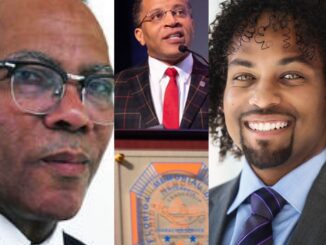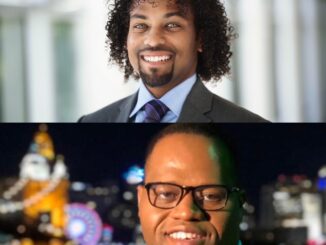
By Kiana Stevenson
NABJ Monitor
ATLANTA – Journalism may be a field with key guidelines, but some professors must shift from the traditional framework to keep young, emerging journalists focused and on top of their game.
This may come as a shock to seasoned instructors who spend class time drilling the AP style guide and newspaper layout into the minds of young students, which is valuable. But, the ever-changing standard of education and society at large have equipped educators with new modes of teaching.
“Our students, they have access to YouTube University and they have access to so many different options and opportunities for learning,” said Jarrad Henderson, Emmy-award-winning video producer and adjunct professor at Georgetown University’s School of Continuing Studies. “You have to be able and capable and keep your skillset up if you want to remain relevant in that energy and be able to pass that down to your students.”
Henderson also serves as the academic representative of the National Association of Black Journalists, a role aimed at faculty development. He added professors are key to the advancement and achievement of the next generation of journalists as the industry becomes more clickbait-based and soiled with tea in a quest for page views and advertising to accommodate for shrinking revenues. Ethical and honest journalism is and will always be necessary for true democracy even if metrics say otherwise.
The digital media landscape is ever-changing and has forced educators, storytellers and newsrooms to be leaner, more limber and craft plans that are forward-thinking. Our forefathers evidently predicted the eventual reign of paperless technology, but the impact of the internet and celebrity culture on society took us all by storm. Today, it is essential to many, including instructors, and has required us to redefine what news is.
“I’m talking to people who are still working in a newsroom and asking them, you know, what they’re looking for when they’re hiring people,” said Michelle Johnson, associate professor of the practice of multimedia/online journalism at Boston University for 11 years. “And so, you know, I have an opportunity to tailor my courses based on that.”
Some may argue that the industry existed for decades without digital, so how pertinent could it be to the craft?
“It’s absolutely required,” said Johnson. “I mean, it’s the way that journalism is done now.”
Last year, the Pew Research Center conducted a study that showed 60% of U.S. adults often get their news from a smartphone, computer, or tablet while 10% get their news from print publications. The study also showed, 52% of adults prefer getting their news from digital platforms, compared to 5% who prefer print. If this is the climate young journalists are merging into post-graduation, professors must consider how vital being well versed in digital is to their students’ success in newsrooms, and crafting curriculums that match the needs of professional newsrooms .
“When studying media, there is this ‘what if’ element to experience that makes one question if you’re even going to succeed,” said Taniece McCoy, graduate of Clark Atlanta University. “I believe that a balance between field experience coupled with media literacy are the foundation for educating future strong media pioneers.”
Many students agree that adaptability is not common among professors who are settled into their careers. Tenure is often to blame for professors at colleges and universities who show little interest in the wants of young people. But Johnson cites it as a potential justification for unchanged curriculum.
“I have friends who work at other schools, and they don’t have much flexibility. Either, you know, it could be because they’re going through the tenure process… so they have publishing responsibilities,” said Johnson. “And there’s some schools, you know, getting anything changed — it’s a process in itself. It can take a long time to get approval to go to make changes to … a course. So it really depends on the institution.”
According to Dr. Meredith D. Clark, assistant professor at the University of Virginia and the Department of Media Studies, the contract for the standard process to get tenure includes certain percentage requirements for research, teaching and service. This must be completed within the first six years of a professor’s hire. Research has a much higher percentage, especially for institutions that are research-intensive or plan to be, which usually takes professors years to complete. With this in mind, it may be difficult to prioritize fresh classroom techniques.
“If I had to venture a guess, I would say that it’s one of the reasons that a number of journalism professors don’t have the most cutting edge version of the skills that they’re trying to teach to students,” said Clark. “We may have the basic skills, but we may not have them for the new technologies that are out, or for some of the new platforms that are available. And that’s because we have to focus our attention elsewhere to make sure that we keep the job.”
But being flexible with new methods of teaching is not impossible despite tenure responsibilities.
Clark, who has extensive experience as a working journalist in social justice, social media, influence of the press and critical race theory is also founding director of the new Center for Communication, Media Innovation and Social Change at Northeastern University.
In Clark’s course on Black Twitter, she made the final assignment for her students a podcast episode. She brought experienced professionals to talk to the students throughout the semester, and she joined in with the class and learned how to create an episode herself.
“To be completely honest, I didn’t know if I could make one myself,” she said. “We can learn some of the tools and some of the platforms that our students are using or will be using. We can learn how they’re relevant to the material we’re teaching. And the way we’re teaching.”
Regardless of your academic appointments, aforementioned research shows it is not enough to solely base one’s teachings on their experience in the industry. If the intention behind lecturing is the audience’s absorption of knowledge, some professors deem it illogical to not take students’ enjoyment into consideration. They argue the best way to keep students intrigued is by catering to their passions and perspectives.

“The biggest thing that I tell people all the time is my job is a talent developer,” said Christopher Daniel, an Atlanta-based journalist recently inducted into the Grammy committee and multimedia professor at Clark Atlanta University. “It really is more than just you holding a class on Tuesdays and Thursdays or Mondays and Wednesdays for an hour and 15 minutes. You are physically there to make sure that whatever vision that that student has, or those students have, they manifest it and then they go after it.”
An equally beneficial by-product of familiarizing oneself with students and their world is potential mentorship. Hampton University graduate Tiana Ruffin experienced firsthand how increased comfortability between staff and students leads to a healthy, successful classroom environment.
Ruffin formed a bond with her public relations professor Keisha Reynolds over the course of her matriculation. When she launched the Tiana Nichelle Marketing Agency last year, Reynolds was an influential figure who Ruffin still frequently goes to for help.
“She was relatable and fun, and she used everything that we would be using right now,” said Ruffin. “She definitely connected with us, and I kind of like watched her. If I had any questions I would always go to her, email her, go to her office hours and just talk to her. She was very open.”
Students believe real-world interaction between working media professionals and student journalists provides realistic definitions of ascendancy. There is no path to prosperity set in stone for every journalist. For young people, the mold often does not stretch enough to include journeys not exactly extraordinary yet equally deserving of triumph.
“They’re always like, ‘As a journalist, you start from the bottom and you gotta work your way up.’ Or you see people straight out of college go straight to it,” said Ruffin. “But you don’t really see the in-between.”
Last year, COVID-19 made it unsafe to convene and nearly impossible to connect. But as we transition back to in-person instruction in the fall, staff and scholars must work together. It is not only essential to humanity, but to the progression of journalism and the development of the best reporters.
“My encouragement to professors out there is to stay curious,” said Henderson. “Ask a lot of questions [to] your students so that you can continue to give them the best opportunity to be successful. I know that’s what I’ve benefited from.”





Be the first to comment